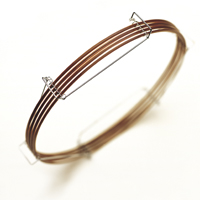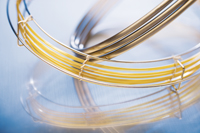
Chromatography
forte BP1
(100% dimethyl polysiloxane)
- Low polariry phase.
- Equivavelent to USP G2 phases.
- An industry standard non-polar phase suitable for all routine analyses.
- An extremely low bleed phase with an high temperature limit of 360°C.
Applications
- Amines
- Drugs of abuse
- Mercaptans, light sulphur compounds and natural gas odorants
- Essential oils
- Pesticides and PCB congeners
- Simulated distillation
- Oxygenates and GROs
- Refinery gases and hydrocarbons
- Solvents impurities
- Semi-volatiles
| ID (mm) | df(µm) | Temperature limits (°C) |
|---|---|---|
| 0.10 | 0.10 | -60 to 340/360 |
| 0.15 | 0.10 | -60 to 340/360 |
| 0.15 | 0.25 | -60 to 340/360 |
| 0.22 | 0.10 | -60 to 340/360 |
| 0.22 | 0.25 | -60 to 340/360 |
| 0.22 | 0.50 | -60 to 340/360 |
| 0.22 | 1.00 | -60 to 340/360 |
| 0.22 | 3.00 | -60 to 300/320 |
| 0.25 | 0.25 | -60 to 340/360 |
| 0.25 | 0.50 | -60 to 340/360 |
| 0.25 | 1.00 | -60 to 340/360 |
| 0.25 | 3.00 | -60 to 300/320 |
| 0.25 | 4.00 | -60 to 280/300 |
| 0.32 | 0.25 | -60 to 340/360 |
| 0.32 | 0.50 | -60 to 340/360 |
| 0.32 | 1.00 | -60 to 340/360 |
| 0.32 | 1.50 | -60 to 300/320 |
| 0.32 | 2.60 | -60 to 300/320 |
| 0.32 | 3.00 | -60 to 300/320 |
| 0.32 | 5.00 | -60 to 280/300 |
| 0.53 | 0.25 | -60 to 340/360 |
| 0.53 | 0.50 | -60 to 340/360 |
| 0.53 | 1.00 | -60 to 340/360 |
| 0.53 | 3.00 | -60 to 300/320 |
| 0.53 | 5.00 | -60 to 280/300 |
forte SolGel-1MS
(100% dimethyl polysiloxane)
- Non-polarity phase.
- Better MS library identification.
- Less bleed - low ion source maintenance.
- Better sensitivity.
- Can also be used for all non-MS detectors.
Applications
- Drugs of abuse
- Essential oils
- Pesticides and PCB congeners
- Solvents impurities
- Semi-volatiles
| ID (mm) | df(µm) | Temperature limits (°C) |
|---|---|---|
| 0.25 | 0.25 | -60 to 340/360 |
| 0.32 | 0.25 | -60 to 340/360 |
forte BP5
(5% Phenyl / 95% Dimethyl Polysiloxane)
- Low polariry phase.
- Equivavelent to USP G27, G36 phases.
- Popular column used for a wide variety of applications.
Applications
- Drugs
- Solvent impurities
- Pesticides
- Hydrocarbons
- PCB congeners or (e.g.) Aroclor mixes
- Essential oils
- Semivolatiles
| ID (mm) | df(µm) | Temperature limits (°C) |
|---|---|---|
| 0.22 | 0.25 | -60 to 340/350 |
| 0.22 | 1.00 | -60 to 340/350 |
| 0.25 | 0.25 | -60 to 340/350 |
| 0.25 | 1.00 | -60 to 340/350 |
| 0.32 | 0.25 | -60 to 340/350 |
| 0.32 | 0.50 | -60 to 340/350 |
| 0.32 | 1.00 | -60 to 340/350 |
| 0.53 | 0.50 | -60 to 340/350 |
| 0.53 | 1.00 | -60 to 340/350 |
| 0.53 | 1.50 | -60 to 340/350 |
| 0.53 | 5.00 | -60 to 280/300 |
forte BPX1
(100% dimethyl polysiloxane)
- Non-polarity phase.
- Polyimide or Aluminium Clad
A 100% polydimethylsiloxane non-polar column for Simulated Distillation in the petroleum industry. This column is coated with a custom-designed phase which gives low, consistent bleed and is ideal for background subtraction. The column is used for ASTM methods D2887 and D6352 and has a maximum temperature up to 430°C for the aluminum clad column.
Applications
- Simulated distillation
| ID (mm) | df(µm) | Temperature limits (°C) |
|---|---|---|
| 0.10 | 0.10 | -30 to 400 |
| 0.53 | 0.10 | -30 to 400 |
| 0.53 | 0.90 | -30 to 400 |
| 0.53 | 2.65 | -30 to 370/400 |
| ID (mm) | df(µm) | Temperature limits (°C) |
|---|---|---|
| 0.53 | 0.10 | -30 to 430 |
| 0.53 | 0.17 | -30 to 430 |
forte BP1 PONA
(100% dimethyl polysiloxane)
- A non-polar phase for PONA analysis.
Applications
- Gasoline hydrocarbons
| ID (mm) | df(µm) | Temperature limits (°C) |
|---|---|---|
| 0.15 | 0.50 | -60 to 340/360 |
| 0.25 | 0.50 | -60 to 340/360 |
Rt-ßDEXm
(permethylated ß cyclodextrin doped into 14% cyanopropylphenyl/86% dimethyl polysiloxane e)
 By adding ß or y cyclodextrin to our bonded Rtx®-1701 stationary phase, we greatly enhance overall utility and column lifetime for the chiral columns, compared to columns that have pure cyclodextrin stationary phases. Separations of more than one hundred chiral compounds have been achieved using our unique DEX columns, and our columns continue to demonstrate stability after hundreds of temperature program cycles. Refer to the applications section of this catalog for examples, or call our Technical Service chemists for assistance in matching a column to your chiral analysis.
By adding ß or y cyclodextrin to our bonded Rtx®-1701 stationary phase, we greatly enhance overall utility and column lifetime for the chiral columns, compared to columns that have pure cyclodextrin stationary phases. Separations of more than one hundred chiral compounds have been achieved using our unique DEX columns, and our columns continue to demonstrate stability after hundreds of temperature program cycles. Refer to the applications section of this catalog for examples, or call our Technical Service chemists for assistance in matching a column to your chiral analysis.
Applications
- General purpose chiral phase with many published applications.
- Terpenes
- Alcohols
| ID (mm) | df(µm) | Temperature limits (°C) |
|---|---|---|
| 0.25 | 0.25 | 40 to 230 |
| 0.32 | 0.25 | 40 to 230 |
Rt-ßDEXsm
(2,3-di-O-methyl-6-O-tert-butyl dimethylsilyl ß cyclodextrin doped into 14% cyanopropylphenyl/86% dimethyl polysiloxane)
 By adding ß or y cyclodextrin to our bonded Rtx®-1701 stationary phase, we greatly enhance overall utility and column lifetime for the chiral columns, compared to columns that have pure cyclodextrin stationary phases. Separations of more than one hundred chiral compounds have been achieved using our unique DEX columns, and our columns continue to demonstrate stability after hundreds of temperature program cycles. Refer to the applications section of this catalog for examples, or call our Technical Service chemists for assistance in matching a column to your chiral analysis.
By adding ß or y cyclodextrin to our bonded Rtx®-1701 stationary phase, we greatly enhance overall utility and column lifetime for the chiral columns, compared to columns that have pure cyclodextrin stationary phases. Separations of more than one hundred chiral compounds have been achieved using our unique DEX columns, and our columns continue to demonstrate stability after hundreds of temperature program cycles. Refer to the applications section of this catalog for examples, or call our Technical Service chemists for assistance in matching a column to your chiral analysis.
Applications
- Essential oils
| ID (mm) | df(µm) | Temperature limits (°C) |
|---|---|---|
| 0.25 | 0.25 | 40 to 230 |
| 0.32 | 0.25 | 40 to 230 |
Rt-ßDEXse
(2,3-di-O-ethyl-6-O-tert-butyl dimethylsilyl ß cyclodextrin doped into 14% cyanopropylphenyl/86% dimethyl polysiloxane)
 By adding ß or y cyclodextrin to our bonded Rtx®-1701 stationary phase, we greatly enhance overall utility and column lifetime for the chiral columns, compared to columns that have pure cyclodextrin stationary phases. Separations of more than one hundred chiral compounds have been achieved using our unique DEX columns, and our columns continue to demonstrate stability after hundreds of temperature program cycles. Refer to the applications section of this catalog for examples, or call our Technical Service chemists for assistance in matching a column to your chiral analysis.
By adding ß or y cyclodextrin to our bonded Rtx®-1701 stationary phase, we greatly enhance overall utility and column lifetime for the chiral columns, compared to columns that have pure cyclodextrin stationary phases. Separations of more than one hundred chiral compounds have been achieved using our unique DEX columns, and our columns continue to demonstrate stability after hundreds of temperature program cycles. Refer to the applications section of this catalog for examples, or call our Technical Service chemists for assistance in matching a column to your chiral analysis.
Applications
- Similar in performance to Rt™-ßDEXsm but provides better resolution for limonene, linalool, linalyl acetate, ethyl-2-methylbutyrate, 2,3-butane diol, and styrene oxides.
| ID (mm) | df(µm) | Temperature limits (°C) |
|---|---|---|
| 0.25 | 0.25 | 40 to 230 |
| 0.32 | 0.25 | 40 to 230 |
Rt-ßDEXsa
(2,3-di-acetoxy-6-O-tert-butyl dimethylsilyl ß cyclodextrin doped into 14% cyanopropylphenyl/86% dimethyl polysiloxane)
 By adding ß or y cyclodextrin to our bonded Rtx®-1701 stationary phase, we greatly enhance overall utility and column lifetime for the chiral columns, compared to columns that have pure cyclodextrin stationary phases. Separations of more than one hundred chiral compounds have been achieved using our unique DEX columns, and our columns continue to demonstrate stability after hundreds of temperature program cycles. Refer to the applications section of this catalog for examples, or call our Technical Service chemists for assistance in matching a column to your chiral analysis.
By adding ß or y cyclodextrin to our bonded Rtx®-1701 stationary phase, we greatly enhance overall utility and column lifetime for the chiral columns, compared to columns that have pure cyclodextrin stationary phases. Separations of more than one hundred chiral compounds have been achieved using our unique DEX columns, and our columns continue to demonstrate stability after hundreds of temperature program cycles. Refer to the applications section of this catalog for examples, or call our Technical Service chemists for assistance in matching a column to your chiral analysis.
Applications
-
Unique selectivity for esters, lactones, and other fruit flavour components.
| ID (mm) | df(µm) | Temperature limits (°C) |
|---|---|---|
| 0.25 | 0.25 | 40 to 230 |
| 0.32 | 0.25 | 40 to 230 |
Rt-ßDEXsp
(2,3-di-O-propyl-6-O-tert-butyl dimethylsilyl ß cyclodextrin doped into 14% cyanopropylphenyl/86% dimethyl polysiloxane)
 By adding ß or y cyclodextrin to the bonded Rtx®-1701 stationary phase, we greatly enhance overall utility and column lifetime for our chiral columns, compared to columns that have pure cyclodextrin stationary phases. Separations of more than one hundred chiral compounds have been achieved using our unique DEX columns, and our columns continue to demonstrate stability after hundreds of temperature program cycles. Refer to the applications section of this catalog for examples, or call our Technical Service chemists for assistance in matching a column to your chiral analysis.
By adding ß or y cyclodextrin to the bonded Rtx®-1701 stationary phase, we greatly enhance overall utility and column lifetime for our chiral columns, compared to columns that have pure cyclodextrin stationary phases. Separations of more than one hundred chiral compounds have been achieved using our unique DEX columns, and our columns continue to demonstrate stability after hundreds of temperature program cycles. Refer to the applications section of this catalog for examples, or call our Technical Service chemists for assistance in matching a column to your chiral analysis.
Applications
-
Often useful in dual-column configurations, with the Rt™-ßDEXsm column, for complex enantiomeric separations.
- Menthol
| ID (mm) | df(µm) | Temperature limits (°C) |
|---|---|---|
| 0.25 | 0.25 | 40 to 230 |
| 0.32 | 0.25 | 40 to 230 |





 0
0
 0
0